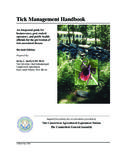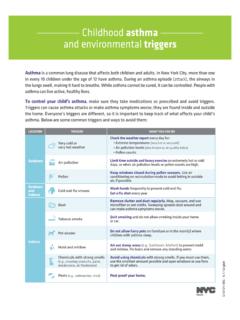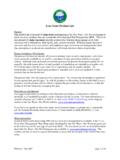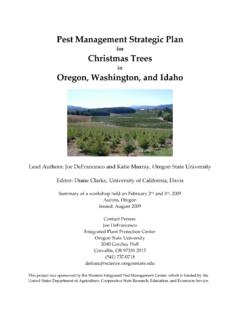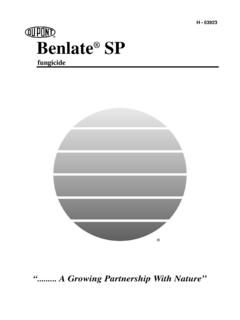Transcription of Classification of the causative agent - Home: OIE
1 NEWCASTLE disease Aetiology Epidemiology Diagnosis Prevention and Control References AETIOLOGY Classification of the causative agent Newcastle disease (ND) is a member of the family Paramyxoviridae in the genus Avulavirus. There are ten serotypes of avian paramyxoviruses designated APMV-I to APMV-10 and ND virus (NDV) has been designated APMV-1. NDV has also been categorised into five pathotypes based on clinical signs in infected chickens, designated: a) viscerotropic velogenic, b) neurotropic velogenic, c) mesogenic, d) lentogenic or respiratory and e) aymptomatic. Pathotype groupings are rarely clear-cut. Temperature: Inactivated by 56 C/3 hours or 60 C/30 minutes. pH: Inactivated by acid pH 2. Chemicals/Disinfectants: Ether sensitive; inactivated by formalin, phenolics and oxidising agents ( Virkon ); chlorhexidine, sodium hypochlorite (6%). Survival: Survives for long periods at ambient temperature, especially in faeces.
2 EPIDEMIOLOGY Hosts Many species of birds both domestic and wild o Chickens are highly susceptible to disease ; turkeys do not tend to develop severe signs o Game birds (pheasants, partridges, quail and guinea fowl) and parrots (order Psittaciformes) vary in susceptibility; cockatiels are susceptible o Wild birds and waterfowl (order Anseriformes) may harbour virus subclinically; some isolates within certain genotypes have caused epiornitics within these species o Young cormorants (Phalacrocorax spp.) have demonstrated disease associated with APMV-1 o disease has been recorded in ostriches (order Struthioniformes) and pigeons (order Columbiformes) are known to be susceptible o Raptors are usually resistant to ND; except reports of acute disease in bearded vulture (Gypaetus barbatus), white-tailed sea eagle (Haliaeetus albicilla), a wild osprey (Pandion haliaetus) and some species of falcons o Other birds known to have been affected by NDV include: gulls (order Charadriiformes), owls (order Strigiformes), and pelicans (order Pelecaniformes).
3 O Passerine birds (order Passeriformes) are variable in their susceptibility; some species show no signs of disease but excrete NDV while others may develop severe disease o Reports of deaths in crows and ravens (genus Corvus) have been recorded o Acute ND has been recorded in penguins (order Sphenisciformes) The morbidity and mortality rates vary among species, and with the strain of virus Humans may become infected; manifested by unilateral or bilateral reddening, excessive lachrymation, oedema of the eyelids, conjunctivitis and sub-conjunctival haemorrhage Transmission Direct contact with secretions of infected birds; principally via ingestion (faecal/oral route) and inhalation Fomites: feed, water, implements, premises, human clothing, boots, sacks, egg trays/crates, etc. o Survival of agent is prolonged by presence of faeces; as in soiled egg shells Hatching chicks may be infected through egg for some NDV strains; transmission of highly virulent isolates is uncommon No clear evidence of role of flies in mechanical transmission Sources of virus Respiratory secretions/discharges and faeces of infected birds All parts of the carcass Virus is shed during the incubation period, during clinical stages and for a limited period during convalescence Wild birds and waterfowl may act as reservoir hosts for lentogenic pathotypes of ND.
4 Subsequently, these viruses could become virulent following mutation upon establishment in domestic poultry Some psittacine birds have been demonstrated to shed ND virus intermittently for over 1 year and been associated with introduction into poultry Occurrence Velogenic NDV is endemic in areas of Mexico, Central and South America, widely spread in Asia, the Middle East and Africa, and in double-crested wild cormorants in the US and Canada. Lentogenic strains of NDV are worldwide in their distribution while widespread mesogenic pathotypes with a special adaptation to pigeons ( pigeon paramyxovirus) do not appear to infect other poultry readily. For more recent, detailed information on the occurrence of this disease worldwide, see the OIE World Animal Health Information Database (WAHID) interface [ ] or refer to the latest issues of the World Animal Health and the OIE Bulletin. DIAGNOSIS Incubation period is 2 15 days with an average of 5 6 days; some species may be over 20 days.
5 For the purposes of the OIE Terrestrial Animal Health Code, the incubation period for ND is 21 days. Clinical diagnosis Clinical signs seen in birds infected with NDV vary widely and are dependent on factors such as: the virus/pathotype, host species, age of host, co-infection with other organisms, environmental stress and immune status. Clinical signs alone do not present a reliable basis for diagnosis of ND. Morbidity and mortality depend on virulence of the virus strain, degree of vaccinal immunity, environmental conditions, and condition of the flock. Lentogenic strains Usually associated with subclinical disease marked by mild respiratory disease ; coughing, gasping, sneezing and rales If other co-infectious agents circulating, can result in severe signs Mortality is negligible Mesogenic strains May produce cause acute respiratory disease and neurologic signs in some species Mortality rate is usually low (<10%) If other co-infectious agents circulating, can result in severe signs Velogenic strains Most commonly cause severe disease in chickens with mortality; signs principally respiratory and/or nervous Initial clinical signs vary but include: lethargy, inappetence, ruffled feathers, oedema and injection of conjunctiva.
6 As the disease progresses birds may develop: greenish or white watery diarrhoea, dyspnoea and inflammation of the head and neck often with cyanotic discoloration In later stages of disease neurologic signs may be manifested as: tremors, tonic/clonic spasms, wing/leg paresis or paralysis, torticollis, and aberrant circling behaviour; also be seen Sharp drop in egg production; eggs contain a watery albumin and appear misshapen with abnormally coloured, rough or thin shells These strains often result in sudden death, with few or no signs Birds that survive serious infection may develop neurologic and partial or complete cessation of egg production Morbidity and mortality rates may approach 100% in unvaccinated chickens Lesions There are no pathognomonic gross lesions; several birds must be examined to determine a tentative diagnosis and final diagnosis must await virus isolation and identification. Only velogenic strains produce significant gross lesions Lesions that may be found include: o swelling of periorbital area or entire head o oedema of the interstitial or peritracheal tissue of the neck; especially at the thoracic inlet o congestion and sometimes haemorrhages in the caudal pharynx and tracheal mucosa; diphtheritic membranes may be evident in the oropharynx, trachea and oesophagus o petechiae and small ecchymoses on the mucosa of the proventriculus, concentrated around the orifices of the mucous glands o oedema, haemorrhages, necrosis or ulcerations of respiratory/digestive lymphoid tissue, including cecal tonsils and Peyer s patches.
7 Though not pathognomonic, ulceration/necrosis of Peyer s patches is suggestive of Newcastle disease o oedema, haemorrhages or degeneration of ovaries o although less evident in older birds, haemorrhages of the thymus and bursa of fabriceus may occur o spleen may appear enlarged, friable and dark red or mottled o some cases may present pulmonary oedema and pancreatic necrosis Differential diagnosis Fowl cholera Highly pathogenic avian influenza Laryngotracheitis Fowl pox (diphtheritic form) Psittacosis (psittacine birds) Mycoplasmosis Infectious bronchitis Aspergillosis Also management errors such as deprivation of water, lack of or nutritionally deficient feed and poor ventilation In pet birds: Pacheco's parrot disease (psittacine birds), salmonellosis, adenovirus, and other paramyxoviruses In cormorants and other wild waterfowl: botulism, fowl cholera and conformational abnormalities Laboratory diagnosis Any laboratory processing samples or undertaking diagnosis from samples should meet the requirements for the appropriate Containment Group as determined by the risk assessment and as outlined in Chapter Biosafety and biosecurity in the veterinary microbiology laboratory and animal facilities.
8 Countries lacking access to such a specialised national or regional laboratory should send specimens to an OIE Reference Laboratory. Samples Samples should be collected from recently dead birds or moribund birds that have been killed humanely. Identification of the agent Dead birds: oro-nasal swabs; lung, kidneys, intestine (including contents), caecal tonsils, spleen, brain, liver and heart tissues, separately or as a pool Live birds: tracheal or oropharyngeal and cloacael swabs (visibly coated with faecal material) from live birds or from pools of organs and faeces from dead birds o small delicate birds may be harmed by swabbing, but the collection of fresh faeces may serve as an adequate alternative Special attention should be given to appropriate types of media for shipping Serological tests Clotted blood samples or serum Procedures Identification of the agent Virus isolation (the prescribed test for international trade): inoculation of embryonated specified pathogen free (SPF) eggs and tested for haemagglutination (HA) activity and/or by use of validated specific molecular methods Virus identification.
9 Use of specific antiserum in a haemagglutination inhibition (HI) test o Cross-reactivity and the risk of mistyping an isolate can be greatly reduced by using a panel of reference sera or monoclonal antibodies (MAbs) specific for APMV-1, APMV-3, and APMV-7 Pathogenicity index determined by intracerebral methodology Pathogenicity index determined by molecular basis Definition of Newcastle disease ; o a) criteria based on either intracerebral pathogenicity index (ICPI) in day-old chicks or o b) correlation of multiple basic amino acids Monoclonal antibodies: for rapid identification of NDV (avoiding cross-reactions with other APMV serotypes) and a valuable method for grouping and differentiating isolates of NDV Phylogenetic studies: allows for the rapid epidemiological assessment of the origins and spread of the viruses responsible for ND outbreaks Molecular techniques in diagnosis: advantage of extremely rapid demonstration of the presence of virus Serological tests Haemagglutination and haemagglutination inhibition tests: most widely used and detects antibody response to virus glycoprotein (predictor of protection against disease ) Enzyme-linked immunosorbent assay (ELISA).
10 As whole virus is used as antigen, detects antibody to all of the virus proteins o commercial ELISA kits available to assess post-vaccination antibody levels For more detailed information regarding laboratory diagnostic methodologies, please refer to Chapter Newcastle disease in the latest edition of the OIE Manual of Diagnostic Tests and Vaccines for Terrestrial Animals under the heading Diagnostic Techniques . PREVENTION AND CONTROL No treatment. Sanitary prophylaxis Bird-proofing houses, feed and water supplies Proper carcass disposal Pest control in flocks; insects and mice Avoidance of contact with birds of unknown health status; including newly acquired domesticated poultry, pet birds and wild or feral birds Control of human traffic; facility employees should not have contact with outside birds and consideration of a policy of shower-in with dedicated clothing Control of vehicular traffic; strict disinfection of conveyances and equipment One age group per farm ('all in-all out') breeding is recommended; disinfection between groups During outbreaks: o effective quarantines and movement controls o destruction of all infected and exposed birds.










